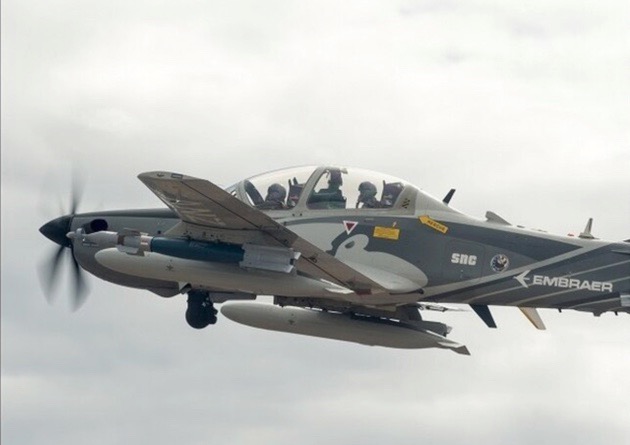
A-29 aircraft by the Sierra Nevada-Embraer team
WASHINGTON: Like the rest of the Defense Department, Special Operations Command is preparing for flat to declining budgets in the coming years as the national debt spirals to $25 trillion and the economy flattens due to COVID-19 related shutdowns.
At the moment, the command that trains, equips and sustains the nation’s elite covert operators boasts a $13 billion budget, $7 billion of which goes directly into buying and repairing new gear, with another $800 million pumped into research and development. And that’s the unclassified part of the budget.
The command wants to protect those investments, Jim Smith, SOCOM’s top acquisition executive, told reporters this morning. But fiscal realities being what they are, “right now, our planning assumptions are based on a flat budget out through the next seven years or so,” he said. “And then, if you take into account inflation, you might even have a slightly downward pressure on our overall budget.”
Just recently, Defense Secretary Mark Esper suggested that the budget pressure might force his hand in cutting older, legacy systems earlier than planned to pull savings toward priority modernization programs like the $500 billion the DoD plans to spend on the refurbishment of the nuclear triad over the next decade.
Earlier this month Esper declared, “we need to move away from the legacy, and we need to invest those dollars in the future. And we have a lot of legacy programs out there right now — I could pick dozens out from all branches of the services” that could be cut or curtailed.
Asked by Breaking Defense if pressure on SOCOM budgets could lead to the command walking away from bigger and older systems, Smith said “SOF is a little different. There is a propensity for us to accept a near-[commercial] solution and get it into the fight very quickly. And for that reason, we tend not to sustain equipment or the 20-year, 30-year life cycles that you see in the services.”
That’s not to say “we don’t have the same pressures,” as the services in finding savings, he added. “We’re trying to divest in a force that you know likes to hold on to things. And so we have very rich dialogue at the command level, I can assure you, about trying to divest over some of our larger programs going on.”
One area commanders want to grow is close air support and ISR in areas without large, improved landing strips via the Armed Overwatch program. Lt. Gen. Jim Slife, commander of Air Force Special Operations Command, said in February at the Air Force Association’s annual meeting that the aircraft would replace AFSOC’s U-28s — and focus more on plane’s close air support, and intelligence, surveillance and reconnaissance (ISR) missions.
Smith today explained that effort is standing on the shoulders of the Air Force’s defunct Light Attack Aircraft effort.
“We are on the backs of the Air Force’s effort. We’re using the same program managers and engineers,” Smith said. “Everything that was learned by the Air Force in their light attack experiment is being leveraged into ours.”
The Air Force’s long-running light attack aircraft saga — that at one point was expected to involve procurement of up to 300 airplanes — began way back in 2011, when the Air Force initiated a program to procure what it then called “light air-support” aircraft for use in insurgencies.
In 2017, the program morphed into what the service called the Light Attack Experiment, aimed at developing a concept of operations that involved US allies as well as fleshing out an overall acquisition strategy. In 2018, then-Air Force Secretary Heather Wilson said the service had set aside $2.4 billion in the fiscal year 2019 budget’s five-year cycle to acquire agile, armed reconnaissance aircraft — once it had tested out its chosen competitors: Textron’s AT-6 and the Sierra Nevada-Embraer team’s A-29.
In October 2019, facing a threat from Congress to strip the program from its control, the Air Force issued a request for proposal to Textron and Sierra Nevada to buy “two or three of both” companies’ turboprops. Finally, in February this year, the Air Force threw up its collective hands and gave up the quest to buy light attack aircraft in quantity — purchasing only two each of the AT-6 Wolverine and A-29 Tucanos for continued experimentation.
Several of the companies who originally fought it out way back in the day under the Air Force effort, as well as Textron and Sierra Nevada, are now throwing their hats in the SOCOM ring. Spokespeople for Air Tractor (which had formally protested the Air Force’s contract award in the light attack competition), Sierra Nevada and Textron confirmed to Breaking Defense today that they are all in for the live-fly demonstration expected in November.
The plan is for SOCOM to buy up to 75 of the aircraft over seven years, beginning with a $106 million request in the 2021 budget to kick things off.
The Special Operations community is as interested in what it can put on one of these planes as it is in the aircraft itself.
“At the end of the day, I’m going to deliver a weapon system,” Smith said. “And so what’s really important to me is what the vendor brings to the table, in terms of their ability to integrate weapons onto a non-developmental platform. I think the Air Force, you know, there was a lot of focus on the actual platforms. I don’t think you’ll see that from SOCOM. We are far more interested in the integration capability of our eventual industry partners on the platform.”






















